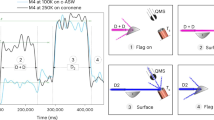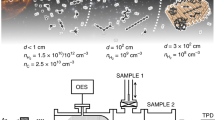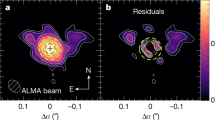Abstract
THE strengths of ultraviolet absorption lines of interstellar hydrogen have been measured in the spectra of several reddened early-type stars1–3. Interstellar H2 molecules are observed mainly in the two lowest rotational levels J = 0 (para-H2) and J = 1 (ortho-H2) with a ratio of populations corresponding to an average temperature ∼ 80 K. This temperature is consistent with the mean HI kinetic temperature determined in 21-cm absorption studies4,5, whereas higher rotational levels up to J = 5 or 6 are populated corresponding to significantly higher excitation temperatures3,6 in the range 150–200K. These observations indicate that a process other than thermal gas collisions is responsible for populating the higher rotational levels. The precise nature of the excitation mechanism is as yet unknown. A process which could contribute to non-thermal excitation of rotational levels involves encounters of charged dust grains with interstellar hydrogen. We have examined this mechanism and find that it could be of comparable, if not greater, importance in relation to other processes which have been proposed.
This is a preview of subscription content, access via your institution
Access options
Subscribe to this journal
Receive 51 print issues and online access
$199.00 per year
only $3.90 per issue
Buy this article
- Purchase on Springer Link
- Instant access to full article PDF
Prices may be subject to local taxes which are calculated during checkout
Similar content being viewed by others
References
Carruthers, G., Astrophys. J. Lett., 161, L81 (1970).
Smith, A. M., Astrophys. J. Lett., 179, L11 (1973).
Spitzer, L., et al., Astrophys. J. Lett., 181, L116 (1973).
Hughes, M. P., Thompson, A. R., and Colvin, R. S., Astrophys. J. Suppl., 23, 323 (1971).
Radhakrishnan, V., Murray, J. D., Lockhart, P., and Whittle, R. P. S., Astrophys. J. Suppl., 24, 15 (1972).
Spitzer, L., and Chochran, H. D., Astrophys. J. Lett., 186, L123 (1973).
Wickramasinghe, N. C., Mon. Not. R. astr. Soc., 159, 269 (1972).
Chiao, R. Y., and Wickramasinghe, N. C., Mon. Not. R. astr. Soc., 159, 361 (1972).
Salpeter, E. E., and Wickramasinghe, N. C., Nature, 222, 442 (1972).
Hayakawa, S., Proc. Symp. Solid State Astrophys. (Cardiff, 1974).
Watson, W. D., Astrophys. J., 176, 103 (1972).
Ferguson, E., Atomic and Nuclear Data Tables, 12, 159 (1973).
Black, J. H., and Dalgarno, A., Astrophys. J. Lett., 184, L101 (1973).
Dalgarno, A., Black, J. H., and Weisheit, J. C., Astrophys. J. Lett., 14, 77 (1973).
Busby, M. R., and Trilling, L., Adv. appl. Mech., Rarified Gas Dynamics Suppl., 5, 1135 (1969).
Dalgarno, A., and Wright, E. L., Astrophys. J. Lett., 174, L49 (1972).
Author information
Authors and Affiliations
Rights and permissions
About this article
Cite this article
TARAFDAR, S., WICKRAMASINGHE, N. Charged dust grains and excitation of rotational levels of interstellar molecular hydrogen. Nature 254, 203–205 (1975). https://doi.org/10.1038/254203a0
Received:
Revised:
Issue Date:
DOI: https://doi.org/10.1038/254203a0
This article is cited by
-
The underexposed effect of elastic electron collisions in dusty plasmas
Communications Physics (2021)
-
Effects of suprathermal grains
Astrophysics and Space Science (1976)
Comments
By submitting a comment you agree to abide by our Terms and Community Guidelines. If you find something abusive or that does not comply with our terms or guidelines please flag it as inappropriate.



